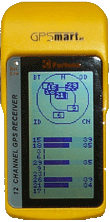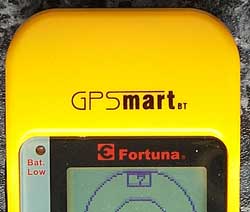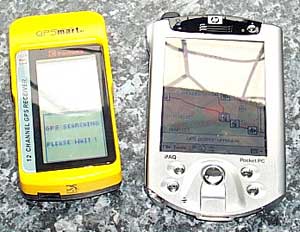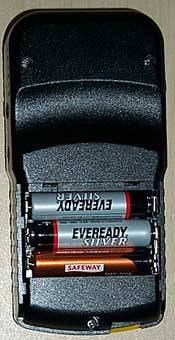|
|
 |
 |
 |
 |
|
Fortuna GPSmart Bluetooth GPS Receiver |
17th May 2003 |
|
| Back in December I reviewed the first ever Bluetooth GPS receiver and was suitably impressed. At the time I thought that the only improvement I wanted to see was the ability to record tracks. |

|
|
 Well Fortuna has gone one better and produced a Bluetooth GPS receiver with traditional hand held features. or is that a traditional hand held GPS receiver with a Bluetooth interface? Is it as good as I could hope for? Well Fortuna has gone one better and produced a Bluetooth GPS receiver with traditional hand held features. or is that a traditional hand held GPS receiver with a Bluetooth interface? Is it as good as I could hope for?
Fortuna is an established (30 years) electronics company based in Taiwan specialising in computer and communications products. They have an impressive range of GPS and tracking products of which the GPSmart is the latest offering.
The review equipment was loaned to us by Premier Electronics who at the time of writing were selling the Fortuna GPSmart for £182.13 or €273.19 including tax and delivery.
The equipment used during this review was the Fortuna GPSmart BT GPS, an
iPAQ 3870, an iPAQ 5450, and a Toshiba Tecra 8000 portable PC with a TDK Bluetooth USB dongle. |
|
What do you get in the box ?
When I opened the GPSmart box I found:
My review package also had a USB data cable in it, this has a dual purpose of data transfer and charging the GPS.
|
Optional Extras
There are a range of optional extras for the receiver:
- Cigarette Lighter Adapter
- Serial data cable
- USB data cable
- Cigarette adapters for iPAQ, Casio, Jornada,and Toshiba PDAs
- Bluetooth adapter (not sure what this is)
|
|
What does it look like?
The Fortuna GPSmart is not a small light GPS receiver, in fact it is a little bit larger then the Garmin eTrex. My first impression was that it looked chunky. The picture to the right shows the size of the GPSmart compared to the HP
iPAQ 5450, as you can see the devices are comparable in size.
The front of the receiver has the display and a battery low indicator. The display screen is a low resolution display with low-resolution graphics.
Located under the GPSmart logo is the patch antenna. You can also see the low battery indicator in this picture.

|


As can be seen from the picture above the GPSmart is about twice the depth of the HP
iPAQ 5450. From this angle you can also see the USB/Serial connector on the base of the unit.
|
|

The picture above shows a size comparison between the Emtac BT GPS, the Fortuna GPSmart and a Nokia 6210. The GPSmart's depth is a shade under twice the size of the Nokia 6210, and is about 25% wider the widest part of the phone.
 On the right hand side of the receiver there are two buttons: power and backlight. On the right hand side of the receiver there are two buttons: power and backlight.
The power button just takes a single push to start the receiver. This can be a bit misleading sometimes as the unit takes a couple of seconds to get started. You can find yourself continually pressing the button waiting for the receiver to come on. It can take a bit of getting used to. |
The underside of the receiver has a groove which is about finger width. The only function I can think of for this is to stabilise the GPS whilst it is being held.
Also on the underside of the receiver is the battery compartment. The GPSmart takes 3 AAA sized batteries not supplied.

|
 On the left of the GPSMart are a button and a rocker. The button provides the Enter functionality whilst the rocker allows the user to move up and down a list of items On the left of the GPSMart are a button and a rocker. The button provides the Enter functionality whilst the rocker allows the user to move up and down a list of items |

On the base of the GPSmart is the USB/Serial connector. This allows the unit to be connected to devices not having Bluetooth support. |
|
Manufacturers Technical Specifications
These specifications are provided by Fortuna from their Website
Key Features of the GPSmart
12 Parallel channels for fast position fixes, WAAS Enable.
Stores more than 3,000 waypoints
Compact size: W=58mm L=119mm H=30mm
Weighs only 110 grams
Multiple scale zoom levels
Can be used as a GPS Smart Antenna outputs NMEA 0183 V2.2
Capability of connecting to PC, Notebook or PDA
Bluetooth (GPSmart ¡V BT Version only)
3 AAA Batteries (Batteries not included)
Back Light
Battery Low Indicator
Navigation Function
Go To Function
Route Function
|
Chipset:
SiRF Star IIe/LP
General:
Frequency: L1, 1575.42 MHz
C/A: 1.023 MHz chip rate
Channels: 12 Channel all-in-view tracking
DGPS Source: Default: WAAS
Standalone functions and screens:
Satellite distribution
Position
Navigation
Map: Max 3,840 marks can be added
Route (20 routes, 31,084 route dots, 3,120 waypoints)
Go To
Database
Set Up (includes an interesting "mirror" mode)
Bluetooth On/Off toggle
Antenna Type:
Embedded patch antenna
|
Accuracy : (DGPS None)
Position: 10 meters, 2D, without SA
Acquisition Rate: (Open Sky and Stationary )
Reacquisition: 0.1 sec., average
Cold Start: 45 sec. typical
Warm Start: 38 sec. typical
Hot Start: 8 sec. typical
Dynamics Conditions :
Altitude: <18,000 meters
Velocity: < 515 meter/second
Acceleration: < 4g
Interfaces:
Serial Port: Mini USB form factor
Bluetooth: Version 1.1
Default baudrate: 38,400 bps
GPS Protocol: Default: NMEA-0183 (V2.0) - GGA, GSA, GSV ,MSS, RMC
Programmable: additional NMEA - VTG, GLL / SiRF Binary
Power Consumption:
w/o BT or BT not enabled: 82-93mA
w/BT (search not yet linked): 145-156mA
w/BT (linked) 113-125mA
|
|
|
How does it Connect?
The GPSmart does not need to be bonded with the PDA the GPS application simply opens the port and off you go. There did seem to be some sort of problem with my
iPAQ 3870 and Bluetooth when switching the GPSmart off the BT manager would not find and other BT devices and did require a soft reset to get other BT devices working again. Switching the Fortuna back on again remade the connection, but the rest of the BT manager functions seemed to have failed. This turned out to be an
iPAQ issue, as it does the same with the Emtac, the difference is that the with the Emtac the
iPAQ BT seems to recover after a while.
Using both the
iPAQ 3870 and the 5450 was simple, once the connection had been released on one the other could pick it up easily. The only real distinction is the annoying way the Bluetooth manager has been changed between the 3x70 and the 5450 versions of the software. The 5450 insists on you selecting the device you want to connect to rather than selecting the default and re-connecting automatically.
Connecting it to the Toshiba portable was just as easy, all I needed to do was define the serial port and open it within my GPS application.
Connecting on both the
iPAQ and the Toshiba now is a simple matter of ensuring that both Bluetooth devices are switched on, then simply starting the GPS application and opening the GPS serial port (if it is not opened automatically by the software). This then opens the connection between the two devices and reports GPS positioning information.
One thing that I did notice was that the Fortuna does not allow itself to be discovered by other BT devices whilst it is connected.
The GPSmart only supports connection to a single device so the utopia of connecting multiple devices to the receiver cannot be realised at the moment. I was, therefore, unable to connect both the
iPAQ and the Portable PC to the GPS at the same time.
Connecting the Fortuna to a computer using the USB cable did not work for me as all Windows XP reported was an Unknown USB device. Again this may be something that has been cleared up in the latest version of the firmware, but I was not able to investigate or program any of the units settings using the serial/USB link. |
|
In Use
The Fortuna is able to connect to the PDA or PC straight out of the box. There is no need to configure it for normal use. I gather that later versions of the firmware require you to bond the device using the passkey "0000". It appears as if this is a requirement for Palm users.
I was surprised yet again at the speed of Fixing. The first fix straight from the box was quick at 2 minutes 3seconds. I don't think that this was a factory fix, but it was a cold fix with the unit having been off for over a week and been moved at least 100 miles. Subsequent cold fixes taking between 37 seconds and 2:14. Typical TTFF was around a minute. In general, when I get into my car I switch the GPSmart on put it on the dash start the car and hook up the
iPAQ by which time I have a fix and can start driving.
What about number of satellites used in fixing and signal strength? Well this again was very good. The antenna and electronics design are excellent. the receiver far outperforms sleeve and compact flash designs. It is no uncommon to regularly get 7 to 9 satellites fixed whilst driving and walking.
The GPS receiver comes with WAAS/EGNOS enabled. During my testing I never saw a Differential fix, this is not surprising as only OziExplorer actually displays the fix type. This is not so reliable as a normal fix because you need line of sight to a single satellite, which although being Geostationary, may not always be available. In Europe the EGNOS system is still in test mode and may not be reliable.
I then decided to put the unit to a real test to see if it's capabilities are comparable to the Emtac. First I put the receiver on the windowsill in my office, I often use this when testing, though with other receivers I would only get a maximum 3 satellite fix. The Fortuna came in strongly with a 5-7 satellite fix, and I even get a 5 satellite differential fix.
I decided to take this one stage further and moved the receiver deeper into the office. I ended up with the receiver on top of a filing cabinet 1.75metres high and 3.5metres from the window. Amazingly I still had a 3-4 satellite fix.
I have had similar experiences when driving, I have found that I can get a very good signal with the receiver in my pocket, or even on the floor between the front seats in a storage compartment in my car.
I have not been able to test the Emtac in situations where there is heavy foliage as it is now spring in the UK, we currently have light leaf coverage and there seems to be no degradation of signal strength
|
Reacquisition
The one thing I have not mentioned yet is the re-acquisition times. The other day I was able to test this in a real environment: Driving through the Dartford Tunnel on the M25. The satellite signal was lost as expected after we were about 50 meters inside the tunnel, as we came out the other side the receiver re-fixed within seconds, far too quickly to time. This, again, is something I have never experienced normally other GPS receivers I have used have taken between two and ten minutes to re-fix. |
|
Configuration
The receiver works straight out of the box so configuration is not required, but built into the software of the device is a certain amount of system configuration.
In the unit I have for review there is the capability to set the time zone; to mirror the display (try it but also remember where the option is); to change the unit of measurement from Meters to Feet; and to clear the memory. On the main menu there is the option to enable and disable the Bluetooth interface.
Later versions of the unit come with revised firmware. This also allows the setting of the position display format from Lat/Lon to OSGB which makes the receiver much more useful in the UK when using it standalone. Unfortunately the upgrading of the firmware requires opening up the case, shorting out some pins and uploading the new software. As I was not able to open my case I cannot tell you what other features are different. Upgrading the firmware is not a task for the weak hearted!!
|
|
The GPSmart screens
The unique aspect of the GPSmart is the screen. Looking at it it looks like a traditional handheld GPS. When you switch it on you are presented with the Fortuna logo and an animated GPSmart logo prior to displaying the Satellite sky view screen.
The graphics are very low resolution on the display, and there is quite a bit of what I can only call colour leak. It is a bit like some of the early computers that used to have block graphics similar to the current teletext. The display is adequate.
The screens available on the GPS are:
- Satellites: The skyview showing the relative positions and strengths of the satellites in view.
- Position: Shows your current co-ordinates Lat/Lon, Fix type, Altitude, Local Time, and speed.
- Navigation:Shows a compass and allows the scrolling of your current co-ordinates Lat/Lon, Altitude, Local Time, elapsed time and speed.
- Route: These features are described below.
- Goto: Allows you to select a waypoint and navigate to it.
- Map: Displays a track and or route on the screen, this can be scaled from 500ft to 18 Miles.
- Area Calculate: provides a calculation of the area of a given trace.
- Database: Allows the selection of routes or the selection and deletion of waypoints.
- Setup: Already described above.
- Bluetooth: Allows the switching on and off of the Bluetooth radio.
|
 |
|
|
Handheld Functionality
Those of you out there that are used to traditional handheld GPS receivers will find track recording, waypoints, routing, and navigation all built in to this device. Having said that the features are very basic and there is no interface allowing the exchange of information between the GPS and either a PDA or PC, other than positional data.
Waypoints
Waypoints are referred to as marks by the Fortuna. A mark can be set at your current location by pressing the "Enter" button when the GPS is active. This will display an editing screen which allows you to: change the icon, edit a default name, edit the location and save the waypoint. There are 16 different icons to choose from. Entering the name of the waypoint is a bit laborious, a little more so than the other handhelds that I have used, but not a lot.
Once the waypoint has been entered there is no further management features other than deletion of the mark.
Tracks and Routes
Why are tracks and routes linked together? Well this is because they are not the normal tracks and routes as a user of a handheld GPS would know them. The routes are set up by recording tracks. Your track is not displayed automatically, you need to start a route trace, which you save and this then becomes a route. Confused? The simple way to describe this is that you can only navigate on a route that you have already traveled. You cannot plan a route by linking waypoints. This is good for retracing you steps, either by back tracking your current recorded route, or by visiting an area where you have already traced a route. The tracing facility seemed to be rather erratic about where the current position was on the screen, with the position often being right at the edge of the screen. This meant that the route you had just traced was not visible, but a blank screen was.
Navigation
Navigation allows you to select a mark, or enter a set of co-ordinates and be directed to the spot selected. This is done by means of a pointer display directing you to your target based on your current heading. The pointer display is surrounded by the four points of the compass so you can see where you are relative to a paper map.
|
|
Power Consumption
The GPSmart is powered by 3 AAA sized batteries. You may use either alkaline or re-chargeable batteries. The quoted battery life is approximately 10 hours, though the battery sets that I used were depleted after about 6 hours using the Bluetooth interface. I did not experiment with re-chargeable batteries as I only have capabilities for AA sized ones.
The Fortuna I reviewed was provided with a USB cable. This cable is used not only for connecting to the USB port on a computer, but also to provide power to the receiver. This is only any good if you have a PC or other device with a USB connector. For use in a car I was nearly stumped until I realised that I had a universal adapter from PC-Mobile this has a cigarette adapter for the car with a USB connector. This powered the GPSmart perfectly during my journeys. Using Bluetooth for a wireless connection is sort of defeated by having the unit connected to the power supply, but it does save on batteries.
|
|
Conclusion
The Fortuna GPSmart is a wonderfully innovative addition to the Bluetooth GPS marketplace. It is packed with features and performs extremely well. It is let down by the user interface for the handheld GPS functions, the range, implementation and interface capabilities of these internal functions, and it's construction.
On one of the occasions that I was changing the batteries one of the battery connectors fell out. It was easy to replace, but it shouldn't happen. The screen displays in low resolution graphics, and has colour leakage.
The reception of signal, its retention of the signal and the ability to recover from loss of fix was impressive.
I am in two minds about the batteries. On the one hand it is great to be able to have disposable batteries that you can change. On the other you find that the unit needs to be powered when in the car, and you just don't leave it on with such abandon as you do a unit with internal rechargeable batteries. I didn't like the idea of having to have a cable running to it in the car, but I did like the freedom standard batteries give you away from a power source.
Overall I think that this is a very good GPS receiver, but not the killer GPS hardware unit I was hoping for.
|
|
|
 |
 |
 |
 |
|
|